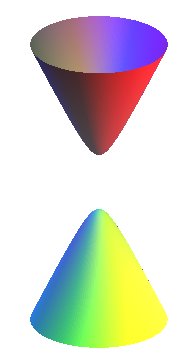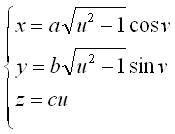TWO-SHEETED HYPERBOLOID H2

| next surface | previous surface | 2D curves | 3D curves | surfaces | fractals | polyhedra |
TWO-SHEETED HYPERBOLOID H2

- the coordinate lines of which give a family of hyperbolas and a family of ellipses:  ,
or ,
or - the coordinate lines of which are the curvature lines:
|
The two-sheeted hyperboloid is the only non-connected quadric.
The two-sheeted hyperboloid of revolution can be defined
as the surface of revolution generated by the rotation of a hyperbola
around its transverse axis. It is the locus of the points M satisfying ,
where F and F' are the common foci of these hyperbolas.
 |
View of the curvature
lines of the two-sheeted hyperboloid; they are circles and hyperboloids
only in the case of the hyperboloid of revolution, otherwise, they are
biquadratics.
The 4 singularities are the umbilics. |
 |
View of one of the two families of circles included in any H2, even if it is not of revolution, with the two corresponding umbilics. |
See also Poinsot
spiral.
| next surface | previous surface | 2D curves | 3D curves | surfaces | fractals | polyhedra |
© Robert FERRÉOL 2017